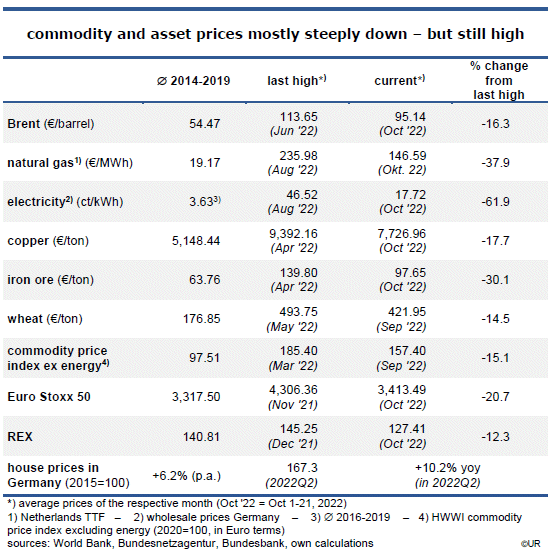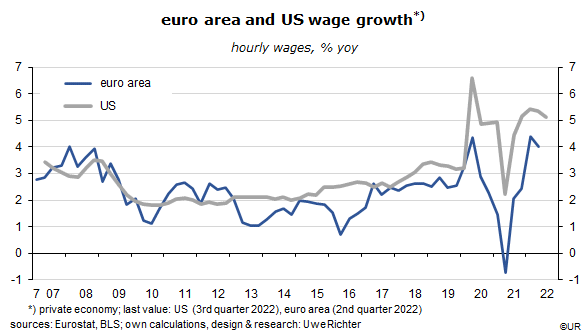
Market Commentary: Early signs of lower inflation rates
Dieter Wermuth, Economist and Partner at Wermuth Asset Management
Analysts largely agree that European consumer price inflation rates are about to fall sometime soon, from an average of 8 ¼% y/y this year to 6 to 7% in 2023 – and then, fairly soon, to something in the vicinity of 2%, the ECB’s target. Similar developments are expected for the US. Looking at the leading indicators and the precarious economic situation, the normalization process could be more rapid than generally expected.
For two main reasons a recession is now under way in the OECD region: the large reduction of real household incomes, as consumer prices have increased a lot more than wages – which has a negative impact on overall demand, and, secondly, because both the ECB and the Fed have aggressively raised policy rates. They have also announced that they will pursue their pro-cyclical policies for as long as it takes to eliminate inflation risks. They are whipping a horse that is already limping. They are convinced that nothing brings down inflation as reliably as a good recession.
I have to admit that at least one important indicator points in the opposite direction, ie, even higher consumer price inflation: industrial producer prices. In Germany last month, they were no less than 46% year-on-year. Retail firms which buy the products of industry will, for the foreseeable future, attempt to pass on these high input prices to their clients. Whether they will succeed, in view of declining real purchasing power, is another question. It will certainly be difficult. Aggressive sales strategies of online traders are an additional difficulty. 46% is quite a challenge. It is unlikely that the pressure in the inflation pipeline will quickly diminish.
Why am I still convinced that inflation at the last stage of the value chain will come down significantly? The main reason are the prices for energy and commodities, main cost components of industrial producer and consumer prices. Since their highs last summer, prices for exchange-traded crude oil, gas and electricity have fallen by 16 to 62 percent. Compared to the years before Covid and the Russian invasion of Ukraine energy remains expensive, but they seem to be in a free fall now and are unlikely to bottom out in the near term. Prices for important industrial metals, or wheat, are also on the way down, if somewhat more moderately, at rates of 15 to 30% since their peak last spring: they had increased by less than energy prices.
Another reason for my optimism is wages. So far there is no evidence of a wage-price spiral which could morph into a new general – and therefore dangerous – inflation mentality. In spite of still robust labor markets on both sides of the Atlantic hourly wages continue to rise a lot slower than consumer prices. The Bundesbank, for instance, reports that Germany’s gross wages and salaries have increased at an annualized rate of only 4.5% in the first two quarters of 2022, and have actually fallen at a rate of 5.7% in the goods producing sector, a subset. American hourly wages were up 5.0% from a year ago in September. These numbers suggest that German (and European) consumer price inflation will probably decline faster than US inflation. Mostly thanks to the strong dollar, US inflation starts from a lower level, though.

The fact that there is no inflation mentality yet is reflected in market-based inflation expectations. Both in the US and the euro area 5y/5y forwards are presently in the order of about 2.3% and thus close to the targets of central banks. 10-year government bond yields tell a somewhat different story: the euro area yield is at 2.4% while US Treasuries are at 4.1% – the difference of 170 basis points can be explained by the relatively strong US economy which is operating closer to capacity limits where higher inflation is normal, or, alternatively, by the euro area’s lower debt-to-GDP ratios.
In any case, central banks’ response to high current inflation rates has actually been fairly mooted. Workers, European ones in particular, are also not expecting that those record high inflation rates are a permanent feature of the economy. Germany’s chemical industry, for instance, has agreed with the labor union to raise hourly wages two times 3¼% in the next two years but pay everybody a onetime bonus of €3,000. This could be the new benchmark in future wage negotiations.
The exchange rate of the euro will probably contribute to the decline of producer and consumer price inflation. Over the course of the year, the euro has massively depreciated against the dollar (-16%) which has become the ultimate safe haven currency. Europe is geographically and economically too close to Russia and its unhinged and unpredictable leader – and has no common military capacity. Europe is too exposed to the risk of war and is, in a way, an American colony.

European fundamentals are actually on par, if not better than America’s: government budget deficits (in % of GDP) are quite similar, while overall European government debt levels are considerably lower. The euro area balance on current account shows a small surplus this year while America has a deficit of almost 4% of GDP – the US remains the world’s largest net importer of capital and is thus at risk of fund withdrawal once peace is established again.
It looks as though the spread between American and European policy rates will shrink in coming quarters which, in turn, will make carry trades at the expense of Europe less attractive. In other words, the depreciation of the euro may soon end and be followed by an appreciation. This will have positive influence on foreign trade prices and reduce European inflation in general.
Finally, in response to the increase of policy rates in both economies, yield curves have shifted up across all maturities. This has resulted in large price declines in the markets for bonds, equities and real estate, the main assets in people’s portfolios. Investors in bonds and stocks and home owners have seen their wealth shrink this year, if only mostly in their books. But they feel less well-off. Real estate prices in Germany are very high (if not in comparison to the anglo-sphere) but have so far kept rising – one million refugees from Ukraine need accommodation. But the dynamics are no longer what they used to be. In the OECD as a whole, the housing crisis has only just begun. Watch out for the next banking crisis.
The process of asset price normalization is still in its early stages and shows no signs that it is about to end. Investors have to wait until central banks begin to indicate that their restrictive policies have rub their course. Overall, the negative wealth effects reduce the demand of households and thus inflation.
Experienced investors know that no one rings the bell when the trend turns. But recent developments suggest that European and American inflation rates are indeed near their peaks.
###
For more information please contact:
Instinctif Partners
Lars Hofer
E lars.hofer@instinctif.com
T +49 162 562 8917
Visit us: https://wermutham.com/
Follow us on Twitter and LinkedIn
About Wermuth Asset Management
Wermuth Asset Management (WAM) is a Family Office which also acts as a BAFIN-regulated investment consultant.
The company specializes in climate impact investments across all asset classes, with a focus on EU “exponential organizations” as defined by Singularity University, i.e., companies which solve a major problem of humanity profitably and can grow exponentially. Through private equity, listed assets, infrastructure and real assets, the company invests through its own funds and third-party funds. WAM adheres to the UN Principles of Responsible Investing (UNPRI) and UN Compact and is a member of the Institutional Investor Group on Climate Change (IIGCC), the Global Impact Investing Network (GIIN) and the Divest-Invest Movement.
Jochen Wermuth founded WAM in 1999. He is a German climate impact investor who served on the steering committee of “Europeans for Divest Invest”. As of June 2017, he was also a member of the investment strategy committee for the EUR 24 billion German Sovereign Wealth Fund (KENFO).
Legal Disclaimer
The information contained in this document is for informational purposes only and does not constitute investment advice. The opinions and valuations contained in this document are subject to change and reflect the viewpoint of Wermuth Asset Management in the current economic environment. No liability is assumed for the accuracy and completeness of the information. Past performance is not a reliable indication of current or future developments. The financial instruments mentioned are for illustrative purposes only and should not be construed as a direct offer or investment recommendation or advice. The securities listed have been selected from the universe of securities covered by the portfolio managers to assist the reader in better understanding the issues presented and do not necessarily form part of any portfolio or constitute recommendations by the portfolio managers. There is no guarantee that forecasts will occur.
Read the full article in PDF format here: English.